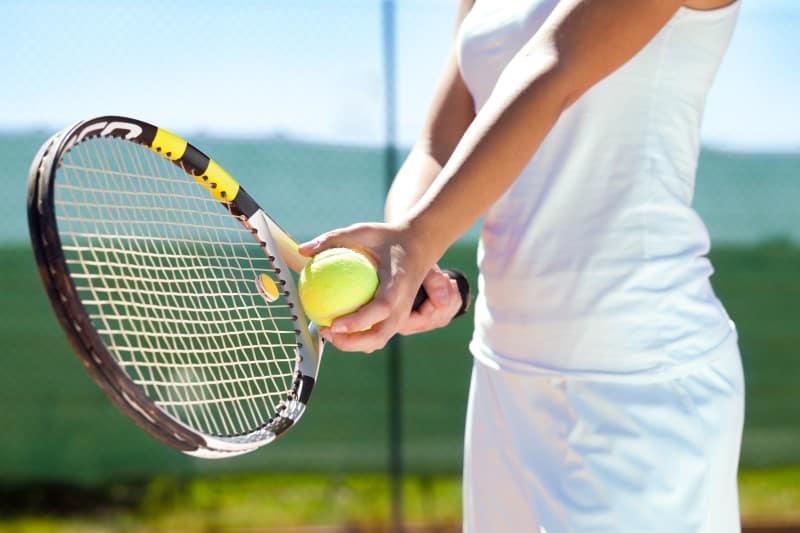If you are a tennis player, sooner or later, you will start wondering about tennis dampeners and whether they are worth it—the debate about whether tennis dampeners work is as old as probably tennis racquets themselves.
Tennis dampeners are pretty small, so a lot of players will wonder if they are really worth it.
Do tennis dampeners work? Tennis dampeners do work but not in the way some tennis players may think. Dampeners will change how the racquet feels and the noise from hitting the ball. However, tennis dampeners do not prevent tennis elbow and other injuries, nor do they improve the longevity of the string and power of the racquet.
As it stands, there may be a lot of misconceptions about tennis dampeners. And in this article, I will go over all the details about tennis dampeners, how they work, and how they will affect your game.

How Do Tennis Dampeners Work?
Have you ever wondered what the little plastic thing on some tennis racquets is? This little plastic accessory on some racquets is a tennis dampener, also known as a shock absorber.
However, dampeners should not be confused with string savers.
Dampeners are built with one purpose in mind—to absorb the vibrations generated when the strings get in contact with the ball.
A tennis dampener will also change the sound on ball contact. That distinct higher-pitched pinging sound will change to a more solid, deeper, and earthy thud.
There are a few common misconceptions about tennis dampeners, though.
- First, a tennis dampener will not affect the overall tension or power of the racquet.
- And second, dampeners do not prevent tennis elbow, wrist, and shoulder pain.
Dampeners are usually very small, and their effect is also fairly insignificant. Yes, a dampener will make your racquet feel a little softer, but if you look at the racquet, you will see that it will still vibrate even with a dampener on—the vibration may end up being a little deadened, but not enough to prevent tennis elbow.
One study aimed to test how effective dampeners really are at reducing the vibration that is transferred through the racquet and down to the arm. According to the researchers, there was no significant difference in the vibration felt in the participants’ forearm between dampened and non-dampened racquets.
Because of that, the researchers suggested that dampeners should be used for their sound-altering effect and the potential placebo effect on tennis players.
Overall, the dampener may affect the string vibrations, but it will not affect the racquet frame vibrations.
This goes hand in hand with the findings and suggestions by other tennis experts, as well.
This is why a dampener is viewed by many players more as a noise dampener than a vibration dampener.
If you are looking for ways to reduce vibration and protect your body, then the tennis racquet itself, how it has been customized, the string, and the grips you use will be more effective in reducing vibrations.
In any case, if you have tennis elbow or shoulder injuries, a dampener may be worth investing in, as it may possibly help.
That being said, some players do swear by the advantageous effects of tennis dampeners. This can easily be tested. Place a dampener on your racquet, hit a few balls, then remove the dampener and hit a few balls again.
Do you feel any difference? To my experience, some players will feel a significant difference, while others won’t. It is hard to say why that may be, but it could be very dependent on your play style, racquet, racquet set up, and body composition.
Where Is a Tennis Dampener Placed?
Tennis dampeners are usually placed around the outer edges of the racquet; One or multiple tennis dampeners can be placed as long as they are outside the string pattern.
The majority of players use just one dampener, which is placed near the bottom of the racquet.
This keeps the dampener away, and the odds of striking the dampener with the ball are very low.
Placing a dampener on your racquet will feel a little strange at first—especially if you have never used a dampener before. It takes some time getting used to it, but after a while, some players find it that they do not like playing with a racquet that doesn’t have a dampener on anymore.
Types of Tennis Dampeners
Generally speaking, there are two main types of tennis dampeners: button-shaped and worm-shaped dampeners.
Worm-shaped dampeners will weave around several of the main strings. They dampen the noise more than button-shaped dampeners, which are put only on two of the strings.
They come in a variety of different sizes, materials, and designs, too. Usually, dampeners are made from rubber or plastic. Of course, other designs and shapes can also be found.
Do Pro Tennis Players Use Dampeners?
Many pro tennis players do use dampeners. However, not all of the pro tennis players use dampeners. In most cases, pros use very lightweight rubber bands as dampeners. Whether a pro player will use a dampener or not is mostly up to personal preference.
Depending on how long you’ve been watching the pros play, you might have noticed that some of them tie rubber bands on their racquets. This is no coincidence or a quirky habit.
Usually, pro players will use a rubber band as a dampener.
Rubber bands come in various sizes, which allows for some freedom and adjustability. The most commonly used type of rubber band is size 64.
The next thing worth mentioning is that rubber bands weigh less than a gram, so they will not be affecting the balance of your racquet in any significant way.
And lastly, rubber bands are super cheap and easy to install. Best of all, they do not fall off. This is more important than it sounds because if the dampener were to fall off while playing, they could lose a point.
But even if the rubber band were to fall off, you can easily replace it with a new one. For a few bucks, you can get a bag with rubber bands that you can use for literally decades.
Is Using a Tennis Dampener Worth It?
Advantages of Dampeners
It may sound a little disappointing, knowing that the most notable change you will experience playing with a dampener is the sound. But there may be more to this than meets the eye.
It can be argued that the subtle change in sound can bring on some advantages with it.
First, the sound is a lot more satisfying. Some players will say that they just enjoy hearing that noise, and this alone is enough to significantly help them with their mental game. On the other hand, you may be able to tell when you’ve hit a good ball simply based on the noise the ball makes on contact.
While using a tennis dampener, your mileage may vary.
Some tennis players say that a dampener helps them do cleaner shots, while others say that they feel like they don’t have the same control with the dampener on.
The altered noise and the reduced vibrations are going to be more than enough for some players.
Tennis dampeners are also very cheap—about $3 to $10 apiece, on average—so they will definitely not break your bank. Not to mention, rubber bands come for a fraction of this price.
If you are curious to find how your racquet will feel with one, make sure to get yourself a high-quality dampener and give it a go.
Disadvantages of Dampeners
Every coin has two sides—where some will see advantages, others will see disadvantages. There are a few things that need to be mentioned.
Since a dampener will reduce the vibrations, this can also reduce the feedback you get at the moment of contact. The feedback you get when hitting the ball is important for improving and adapting your technique.
Although not all tennis players may experience this, some who are relying more on the feedback they get from the contact may perform worse with a dampener.
Dampeners are also known to fall off the racquet. Spending a good $3 to 5$ on a dampener, which then falls off and gets lost after a few games, is not a pleasant experience. (This is why a rubber band is recommended instead.)
At the end of the day, it all comes down to personal preference. Some players will swear by their dampeners, while others will do a lot better without using them.
Can a Tennis Dampener Make You a Better Player?
I have been asked that question a few times, and it is my belief that it should be addressed.
Some tennis players are left with the wrong impression that a dampener can make them better players. However, a tennis dampener cannot make you a better player.
A dampener will not improve your accuracy, consistency, spin control, or power.
With that being said, it can be argued that there could be a placebo effect at play here, and some players may see an improvement in their game. The different (and more pleasing) sound of the ball hitting the strings and the slight change in feel may indirectly improve somebody’s game.
Overall most of the players may find using dampeners to be beneficial to their game.
At the very least, it is worth experimenting with.
Don’t completely dismiss tennis absorbers before giving them a chance to prove themselves for you. All tennis players are different, and in order to find what works best for you, you need to experiment.
Read our full review on Best Tennis Vibration Dampeners.
